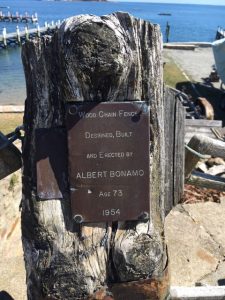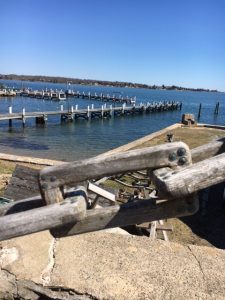
By Dan Pearson
Author Stephen Jones referred to time in Noank as the “ethereal years.” And there remains something otherworldly and uniquely graceful about the place. Most likely, this is because of the way the village dips and soars so that even after hundreds and hundreds of walks up and down its streets I never fail to be engaged and surprised by the vistas out over Fishers Island Sound. It’s a maritime village if there ever were one. I’m not a sailor. I don’t have the patience for the caprice of wind and wave, but rather prefer to feel it from the closest verge as opposed to heeling at its mercy. But those views from the top of Riverview, the seascape from Potter looking out over Fords, sailor or not, wherever I go in Noank I feel propelled ocean-ward with a renewed or rejuvenated sense of light and air, color and climate, and the interplay between wind and whitecap. From the base of Smith Court, standing next to Robert Brackman’s former studio, I get a glimpse of the sea through the trees and houses. A minute later, from the top of Riverview and Palmer Court, I gaze out on three states and get the breadth of the panorama, the archipelago, the contours, the expanse. There’s nothing else like it.
Pop up ads. Texting drivers. Bulk mail from Geico or the like cleverly disguised to look official. Phone phone phone image image update reminder. I feel like I spend a lot of my life fending off, so it is nice when there are moments to reflect instead of deflect. Slow Art Day asks that of us and, in doing so, puts me in mind of Noank. Of details. Of pauses. Of memory, decay, and renewal. Of the powerful beauty and texture of changing weather. I don’t live in Noank, and I actually never have, although I grew up across the cove. But I suppose that when I go and take a stroll the village enters my spirit so that it lives in me and stays with me to remind me to find joy in simple pleasure. To stop and awaken all my senses.
Take for example the artistry and craft of the wooden link fence at the bottom of Riverview. It slows me down, every time, and takes me someplace else, someplace older and somehow more substantial. There are so many restorative sights and sounds. Another generation of kids jumping off the pilings into the river. The oyster boat and the workboats. The plaintive ringing of the buoy bells. The fog and haze cooking itself off in the summer. The houses and their dental work or ornate Italianate detail, the village just big enough to provide assortment but small enough to be manageably experienced.

In the same way that Slow Art asks us to give a little bit more consideration to detail, to the artist’s intent, inspiration, and talent, Noank, for me at least, but I know for many others, asks us to look into a moment and examine it for all its worth, and by doing so, helps to take stock of moments passed and moments to come, reminds not to let life pass over but demands we wring it out for all the beauty, pain, and mystery that comes together to make it.
Noank, like any coastal village with its marine services, historic homes, and proximity to New York, Hartford, and Boston, is gentrifying but not as rapidly, aggressively, or as divisively litigiously as other places, despite some recent history. The village seems, somehow, to retain its soul and quiet dignity. Perhaps there is a humility that sets in when pit so directly against the drama of all that grand sea and space, where every little pointillist dot also has its crucial place in the picture.
Dogs used to sleep in the street in front of Carsons, refusing to move for anyone. It was good sport to watch from one of the spinning counter stools inside. I used to talk with Tommy Burbine about the days of rum runners and coastal patrols. The historical society could correct me on this, but I’m pretty sure Adele Kress lived in Noank about 87 years, but would always tell me she wasn’t “local” because she was born on Block Island. Noank likes to keep itself a secret. I can feel the ghosts in the room with me cursing me for even this little bit of praise or publicity. Well, I say to them, I wasn’t the one to install the “speed humps.” But that’s not the point. The point, one I think Stephen Jones tried to make all those years before in his book, Noank: The Ethereal Years, is that Noank is a place but it often transcends that to become a consciousness, a place we can and should visit all the time if we will just slow down and take a close enough look around to find it is always right there in front of us.

